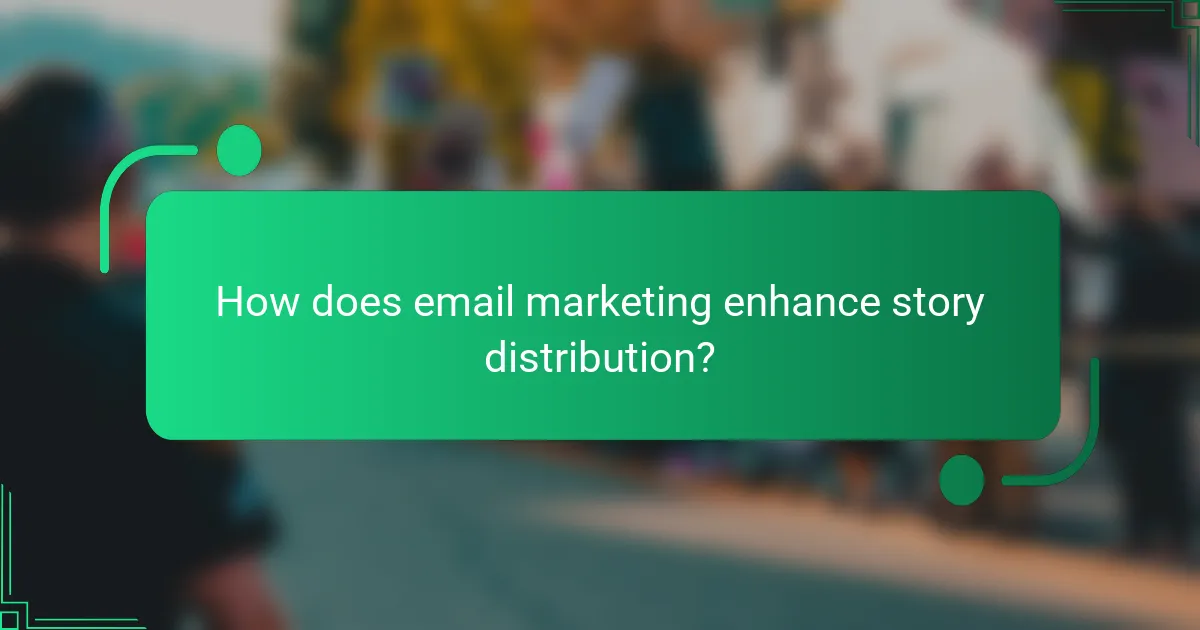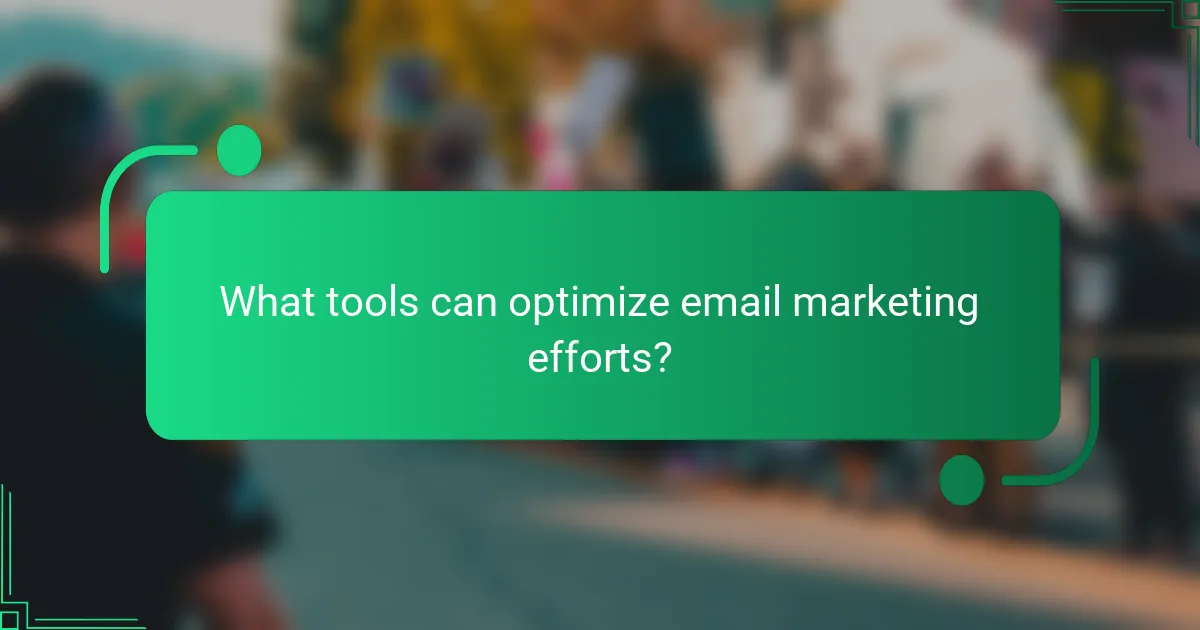Email marketing plays a crucial role in story distribution by enabling brands to connect directly with their audience through tailored campaigns. This targeted approach not only ensures that stories reach interested subscribers but also enhances audience engagement by fostering personalization and interactivity. By measuring key performance indicators, brands can effectively assess the impact of their email strategies on audience response and loyalty.

How does email marketing enhance story distribution?
Email marketing significantly enhances story distribution by allowing brands to directly connect with their audience through targeted campaigns. This method ensures that stories reach subscribers who are already interested in the content, increasing the likelihood of engagement and sharing.
Direct audience reach
Email marketing provides a direct line to your audience, bypassing social media algorithms that can limit visibility. By sending newsletters or updates, brands can ensure their stories are delivered straight to the inboxes of interested readers.
To maximize reach, segment your email list based on interests or demographics. This allows for tailored messaging that resonates with specific groups, improving the chances of engagement.
Personalized content delivery
Personalization in email marketing enhances the relevance of the stories shared. By using data such as past interactions or preferences, brands can customize content to match the interests of individual subscribers.
Consider using dynamic content blocks that change based on user behavior. For example, if a subscriber frequently engages with travel stories, prioritize similar content in their emails to keep them engaged.
Increased engagement metrics
Email marketing can lead to higher engagement metrics, such as open rates and click-through rates, compared to other channels. Engaging subject lines and compelling content can entice readers to open and interact with emails.
To boost engagement, regularly analyze performance metrics and adjust your strategies accordingly. A/B testing different subject lines or content formats can help identify what resonates best with your audience, leading to continuous improvement in engagement. Aim for open rates in the low to mid-twenties percent range as a benchmark for success.

What are effective email marketing strategies for audience engagement?
Effective email marketing strategies for audience engagement focus on personalization, relevance, and interactivity. By implementing targeted approaches, brands can foster deeper connections with their audience, leading to improved response rates and customer loyalty.
Segmentation and targeting
Segmentation involves dividing your email list into smaller groups based on specific criteria such as demographics, behavior, or purchase history. This allows for tailored messaging that resonates more with each group, increasing the likelihood of engagement.
Consider using criteria like geographic location, past interactions, or interests to create segments. For example, a retailer might send different promotions to customers in urban areas compared to those in rural settings. This targeted approach can enhance relevance and drive conversions.
Compelling subject lines
Compelling subject lines are crucial for capturing attention and encouraging opens. Aim for clarity and intrigue while keeping them concise, ideally under 50 characters. A strong subject line can significantly impact open rates, making it a key element of your email strategy.
Incorporate action-oriented language or personalization, such as using the recipient’s name or referencing their previous purchases. For instance, “John, your favorite shoes are on sale!” can create a sense of urgency and relevance.
Interactive content inclusion
Including interactive content, such as polls, quizzes, or videos, can enhance engagement by making emails more dynamic and enjoyable. This type of content encourages recipients to participate actively rather than passively consuming information.
For example, a travel agency might include a quiz to help users find their ideal vacation destination. This not only engages the audience but also provides valuable insights into their preferences, allowing for more personalized follow-up communications.

How can brands measure the success of email campaigns?
Brands can measure the success of email campaigns through various key performance indicators (KPIs) that reflect audience engagement and conversion effectiveness. By analyzing metrics such as open rates, click-through rates, and conversion rates, companies can gain insights into how well their emails resonate with recipients and drive desired actions.
Open rates analysis
Open rates indicate the percentage of recipients who opened an email, serving as a primary measure of engagement. A typical open rate for email campaigns can range from 15% to 25%, depending on the industry and audience. Brands should aim to optimize subject lines and send times to improve these rates.
To analyze open rates effectively, segment your audience based on demographics or behavior. This allows for tailored messaging that can enhance engagement. Regularly testing different approaches, such as A/B testing subject lines, can also yield valuable insights.
Click-through rates tracking
Click-through rates (CTR) measure the percentage of recipients who clicked on links within an email. A good CTR typically falls between 2% and 5%, but this can vary widely by industry. High CTRs indicate that the content is compelling and relevant to the audience.
To improve CTR, ensure that calls to action (CTAs) are clear and enticing. Use engaging visuals and concise text to draw attention to clickable elements. Monitoring CTR over time can help identify trends and inform future content strategies.
Conversion rate evaluation
Conversion rates reflect the percentage of recipients who completed a desired action, such as making a purchase or signing up for a newsletter. A healthy conversion rate often hovers around 1% to 3%, but this can differ based on the campaign goals and audience. Understanding what constitutes a conversion for your brand is crucial.
To evaluate conversion rates, track the journey from email click to action completion. Use analytics tools to identify drop-off points and optimize the user experience on landing pages. Regularly reviewing and adjusting your email content and offers can significantly enhance conversion outcomes.

What tools can optimize email marketing efforts?
To enhance email marketing efforts, utilizing the right tools can streamline processes, improve engagement, and provide valuable insights. Automation, analytics, and design capabilities are essential features to consider when selecting these tools.
Mailchimp for automation
Mailchimp is a leading platform for automating email marketing campaigns. It allows users to set up automated workflows based on user behavior, such as welcome emails for new subscribers or follow-ups after purchases.
Consider using Mailchimp’s segmentation features to target specific groups within your audience. This can increase engagement rates significantly, as tailored content resonates better with recipients. Regularly review and adjust your automation settings to ensure they align with your current marketing goals.
HubSpot for analytics
HubSpot excels in providing comprehensive analytics for email marketing campaigns. It tracks key metrics like open rates, click-through rates, and conversions, helping marketers understand what works and what doesn’t.
Utilize HubSpot’s reporting tools to analyze the performance of different campaigns over time. This insight can guide future strategies and optimize content for better audience engagement. Regularly assess your analytics to refine your approach and avoid common pitfalls, such as ignoring low-performing emails.
Constant Contact for design
Constant Contact offers robust design tools that enable users to create visually appealing emails. Its drag-and-drop editor simplifies the design process, making it accessible even for those with limited technical skills.
Take advantage of Constant Contact’s templates to maintain brand consistency while saving time on design. Experiment with A/B testing features to determine which designs resonate best with your audience. Ensure that your emails are mobile-friendly, as a significant portion of users access emails on their smartphones.

What are the best practices for email list building?
Effective email list building is crucial for successful email marketing. It involves strategies that attract potential subscribers and encourage them to join your mailing list.
Incentivizing sign-ups
Offering incentives is a powerful way to boost email sign-ups. Consider providing discounts, exclusive content, or entry into a giveaway as rewards for subscribing. These incentives can significantly increase conversion rates.
Make sure the value of the incentive is clear and relevant to your target audience. A well-structured offer can lead to higher engagement and retention rates in the long run.
Utilizing social media
Social media platforms are effective channels for driving email sign-ups. Share links to your subscription form on your profiles, and create engaging posts that highlight the benefits of joining your email list.
Consider running targeted ads on platforms like Facebook or Instagram to reach a wider audience. This approach can help you attract users who are genuinely interested in your content and likely to engage with your emails.
Creating valuable lead magnets
Lead magnets are valuable resources offered in exchange for email addresses. Examples include eBooks, whitepapers, or webinars that provide useful information relevant to your audience’s interests.
Ensure that your lead magnets are high-quality and align with your brand. This not only attracts subscribers but also establishes trust and authority in your niche, encouraging ongoing engagement with your emails.
